October 5, 2023: I make long and not very exciting trip down Chesapeake Bay in mostly perfect weather to meet up with a friend.
The anchorage was crazy quiet all night. The water was calm. I slept soundly.
It was dark when I woke around 5 AM. Nothing unusual. I made some coffee and settled back into bed to drink it, do my morning puzzles, and catch up on social media. The puzzles have become a morning brain test for me. So far, my brain is still functioning quite well.
Then I settled down in the dining area to write up the previous day’s blog post. It took a long time because I wrote a lot. (I’ll try not to do that today.)
The sun rose into a cloudless sky.
Eventually, my pups got up. I fed them and loaded them into the dinghy for our last trip to the sand spit. Once again, our arrival chased all the seagulls off the spit. The trip was a success and, although my pups wanted to race around on the sand a little, I loaded them back into the dinghy and we went back to the boat.
I had some oatmeal, finished up the blog post, and sent it to my blog. It felt good to be blogging about the trip again, to be putting down the details in a way that I’d remember it and be able to share it with others. There’s so much that goes on every day and writing it down is the only way I’ll remember it in years to come.
Making a Plan
It was about 10 AM when I was ready to move on. I’d originally planned to go to Solomons and anchor out in one of the creeks there. The next day, Friday, I’d meet up with my Mastodon friend Jason who lives aboard his very large boat in Washington DC. He’d come down the Potomac and was staying at a marina not far from the river’s confluence with Chesapeake Bay.
We got to texting and he had taken Friday off. The weather on Thursday and Friday was supposed to be very good with rain coming on Saturday. Solomons wasn’t that far from Smith Creek, a tributary to the Potomac near its mouth. It seemed to make sense to skip Solomons and meet up that evening at Smith Creek so we’d have all day Friday with good weather to do stuff together. I suggested this to Jason and he was game. He had to work until 3:30 and then he needed to wait a little longer for the tide to come up in the creek where his boat was docked. He could be at Smith Creek not long after me.
With this plan set, I programmed a route into Aqua Map on my iPad. Then I set about doing the things that needed to be done to move out: stowing loose items, getting the dinghy back on its davit, checking the engine compartment and oil, setting up the command bridge with the equipment I needed for the day, getting the life jackets on my pups, and settling my pups on the seat up in the command bridge. The usual routine.
An Engine Alert
It was about 10:45 when I started the engine. And about 30 seconds later when my chart plotter started beeping. Low Engine Coolant, it said. I pushed the button to kill the engine.
Okay, not a problem. The cooling system had been serviced on Tuesday, right before I left. Maybe Frank, the mechanic, hadn’t added enough coolant. I had a jug of the stuff that he’d left behind so I just had to make sure I put the right amount in the right place.
I pulled out my copy of the Volvo Penta D4/300 manual. I found the cooling system page. I saw how to check and top off the coolant. I opened the engine compartment, opened the cap for the coolant — slowly, to release pressure first — and peeked inside. Yes, there was coolant, but it was low. Rather than maneuver the five liter jug over the filler hole (and spill yellow coolant all over my engine), I poured coolant into a little half cup container and used that to add coolant to the engine. I had to do that four times — it was really low. I’m not sure why the alert hadn’t appeared the day before. Maybe it was a startup check that had triggered the alert?
I closed up everything except the engine lid and restarted the engine. Everything inthe engine compartment looked and sounded fine. There was no alert.
Departure
I closed the engine lid and walked up to the bow to retrieve the anchor. I’ve learned from experience that the best way to haul up my anchor from the bow is incrementally, pushing the Up button on the windlass in short bursts to keep the bow pointed toward the chain and get the boat moving gently toward the anchor. In the past, one of my friends on board with me had just pushed the Up button to crank away at the anchor line, causing it to get fouled up when the boat twisted. This happened twice, causing me a lot of grief both times. I’m careful when I pull the anchor in — heck, there’s no hurry! — and have not had any problems.
The only problem that day was mud in the chain. My boat does not have an anchor wash so any mud on the chain ends up in my anchor locker. Bringing the chain up slowly minimizes this because the chain is better rinsed as it comes up. But I used the Down button a few times to give it an extra dip.
When the chain was straight down, I knew the anchor was off the bottom. Now time was of the essence. I had to get the anchor up the rest of the way and locked into its holder quickly so I could get up to the helm before the boat drifted very far. There wasn’t much wind or current that morning, so it wasn’t a huge deal. But I think that from the moment the chain went straight to the moment I was at the controls was less than 60 seconds.
I pushed the throttle into forward idle and we headed out at 3 knots. It was exactly 11 AM.

The smaller of the two sailboats had departed about an hour before me, but the big pretty one was still at anchor. I took a photo of it at anchor, mostly to help me remember what a nice anchorage it had been.
The Cruise
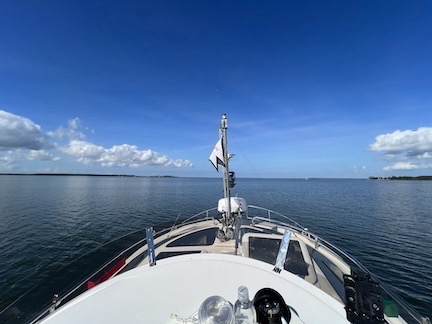
A view from the command bridge as we headed down the Choptank River to Chesapeake Bay. Could I ask for calmer conditions?
I don’t have much to say about the cruise. Other than some swells when we left the Choptank River and got into Chesapeake Bay, the water was crazy calm. I used Otto my autopilot to steer me out into the main channel of the bay. Although there had been some fishing boats and a few pleasure boats in the river, the bay was pretty much empty.
We had a total of nearly 60 nautical miles to cover and had gotten what I consider a late start. So I pushed the throttle forward, running the engine at 2900 RPM to give me about 13 knots of speed. The boat felt good — the work they’d done on the prop definitely made a difference in the vibrations I’d felt on the first part of my trip from Chicago. Was I getting better performance? Maybe. I’d have to compare notes. I log performance info throughout my cruising day.
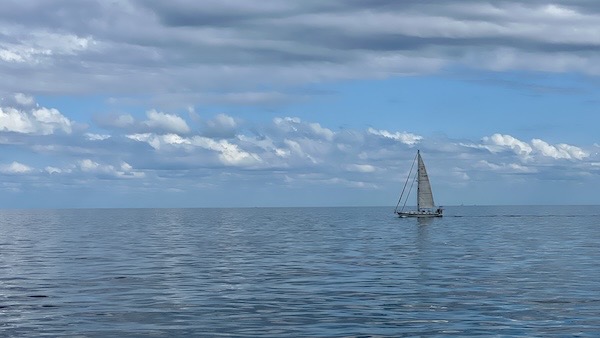
One of the few boats I passed in Chesapeake Bay. Also one of the few sailboats I saw that actually had a sail up. (What’s up with that, sailors?)
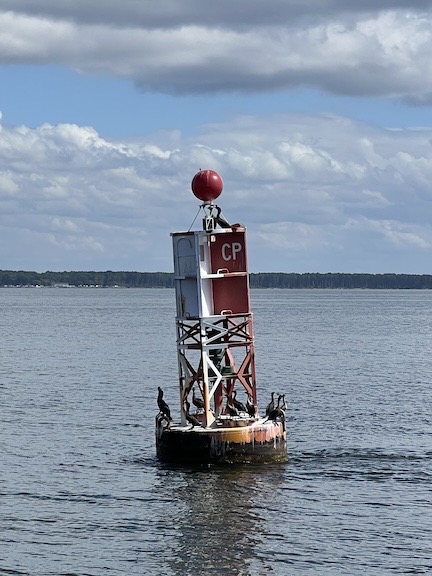
Cormorants on a buoy in Chesapeake Bay.
At about 12:30, I took a break to go into the cabin and make some lunch. I was in the middle of Chesapeake bay with no obstacles or other traffic around me, so I just idled the engine, told my pups to stay, and went downstairs. I used the microwave to reheat some leftovers and grabbed an apple and a fork. Then I went back upstairs, settled into my seat, and throttled back up. I ate lunch while Otto drove.
Along the way, it started clouding up. That surprised me; the weather was supposed to be good for the next two days. When the sun went behind the clouds, it got surprisingly chilly. I would think about retreating to the inside helm and then the sun would come back out and it would be warm again and I’d stop thinking about it.
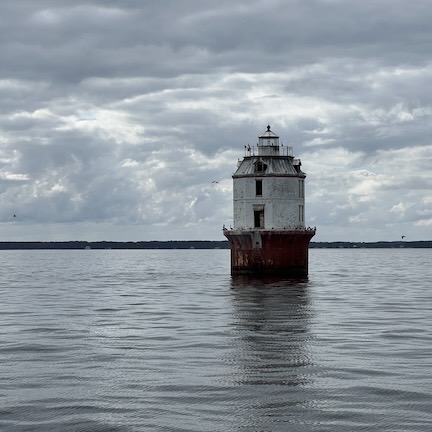
Point No Point Light on the west side of Chesapeake Bay.
By the time I passed the Point No Point light, it was downright nasty looking up ahead. The water was still calm though, with only a tiny chop. I started wondering if it would rain on us.
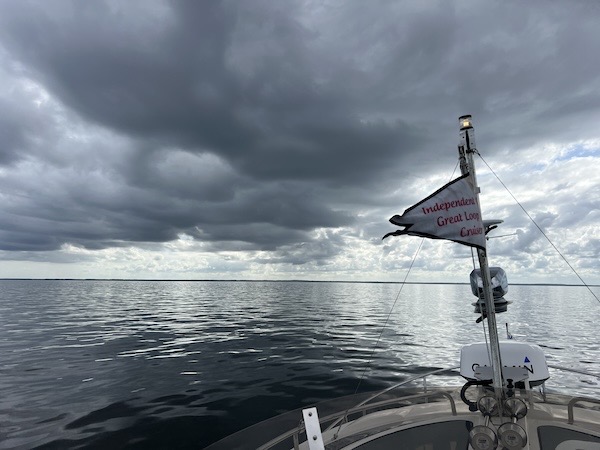
The clouds were really building up on the south end of the bay.
I programmed the chartplotter with a course that would get me into Smith Creek and told Otto to follow it. I pushed the throttle up to 3000 RPM and got 14+ knots. By this point, I was in communication with Jason, who had been watching my progress on AIS. I told him which anchorage I was heading to. It looked like I’d arrive at 3:30.
Getting to Smith Creek Anchorage
Otto steered us into the mouth of the Potomac River. The conditions were still calm and it was a bit less cloudy up ahead. From there, it was a short ride to the channel into Smith Creek. I noticed that my programmed route had missed a channel marker, so I gave Otto the rest of the day off and hand steered the boat.
A sailboat was ahead of us and it made a weird turn as it dropped and stowed its sail. I slowed way down and passed it. The two folks on board waved and I waved back.
Then I was coming into the creek and it was drizzling on me. Really? I was too close to the anchorage to reposition myself and my pups downstairs, so I just took it. It got worse before it let up. I manevered to an open area between two marinas, off to the side, got the boat to a standstill, and went down to the bow to drop the anchor. I was in 10 feet of water at low tide so I dropped about 50 feet of rode, easing it out slowly as soon as the boat started to drift away from the anchor.
I went back to my phone and set an anchor alarm since the wind had picked up and I wasn’t sure how well the anchor had set.
The rain now over, I killed the engine and electronics, stowed the radio, covered the electronics, collected my stuff, and coaxed my pups to follow me down the stairs. we were settled in until Jason arrived.
At Smith Creek Anchorage
Although I wasn’t thrilled with the anchorage, it did have one benefit: a marina I could dinghy over to so my pups could do their business. We did that right away.
Then I cleaned up the inside of my boat. I still hadn’t finished unpacking — I had no idea where I was going to stow all the stuff I’d brought — so most of it went into the “Cave” under the table. That got the table and seating areas cleared. I busied myself unpacking two more boxes before Jason arrived. It was nearly sunset.
Jason’s boat is big. At least 10 feet longer and 4 feet wider than mine. The plan was for him to anchor his boat and me to raft onto it. The only rafting I’d done in the past was in locks. I pulled my anchor and moved my boat out of the way. Jason brought his boat into position. I had fenders down on my starboard side and he had his down on his port side. When he gave me the signal, I moved in slowly, steering from the inside helm. I was able to hand him a midship line. The boats were perfectly separated by all those fenders. Easy peasy.
Of course, one of the reasons it was so easy was that the wind had died down completely and there was no real current. And my boat has side thrusters.
I took a few minutes to feed my pups and take them by dinghy to do their business again. Then I put them into the cabin and boarded Jason’s boat. I grilled up some sausages while he made a salad. We ate and had drinks on his enormous aft deck.
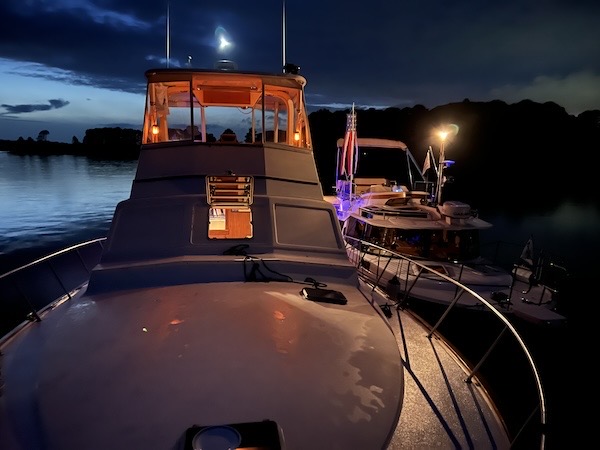
Shot from the tip of Jason’s bow, my boat looks tiny beside his.
We talked until 11:30. I went back to my boat and was asleep before midnight, suspecting that that second drink was a mistake. (It was.)
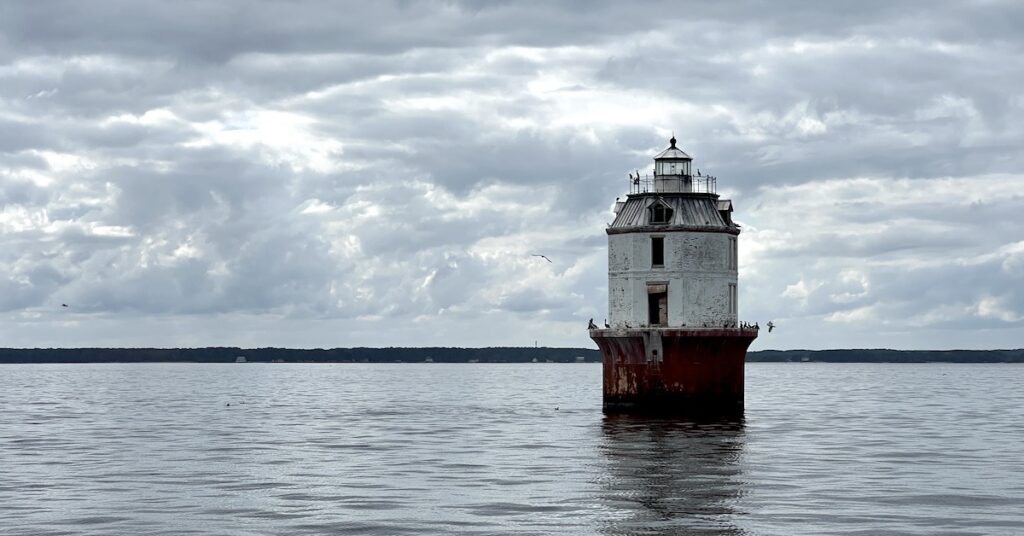
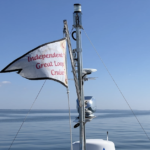

I am delighted to be reading your blogs again! Your style of writing suits me perfectly.
I am living a bit vicariously through you right now. I was going to purchase a boat, learn it a bit, and do the loop. Solo. A recent discovery of a tumor has me on hold. Biopsy is scheduled. So keep up the good work, it helps me get through my temporary (I hope) health problems.
By the way, I think the second drink was perfect! (Slept well right?).
Sincerely,
John
Sorry about your delay and its cause. I hope it isn’t anything too serious.
As for that second drink, it was definitely a mistake. I felt hungover the whole second day.
Thanks so much for taking the time to comment. It’s the comments that keep me writing — and now I’m already behind two days!